Age impacts the preferences and habits of new gym members. Get insights into generational trends in this article. So, you can adapt your approach to sales and retention to suit your target audience.
Reviewing generational trends will help you understand where opportunities exist for your business to attract and retain existing and new members.
Consistently winning new members, while minimising attrition, is a non-negotiable if you want to build a thriving business for the long-term.
The Gym Membership Sales Report features exclusive insights from across the UK fitness industry. Plus, tips and tricks to help you attract and keep more members for longer.

In this article, we’re breaking down those findings further to take a generational look at sales.
Let’s get stuck in!
About the gym membership sales research
AboutThe sales insights in this article are from the Gym Membership Sales Report. The research looked at Xplor data from 929,169 first time Direct Debit membership sales from across the UK & Ireland. These new members had membership agreements starting between January 2013 and March 2024. The data was collected in April 2024. Data from 2020 and 2021 has been excluded when reviewing the month and quarter that membership agreements started in. This minimises the impact of COVID closures.
Get your free copy of the reportSay hi to our generations
People are inherently different. Yet, people do usually have some common lived experiences based on when they were born.
Generational theory suggests that during each era (lasting 20-25 years) a unique social, political, and economic climate exists. This has a direct impact on the people growing up and living through it. And shapes their values, worldview, and life choices.
In short, shared lived experiences can impact preferences and expectations, as well as lifestyles and habits.
The gym membership sales research covered 5 key generations for gyms and fitness clubs:
Gen Z
The youngest generation of gym members are well and truly here! Born between 1997 and 2012, Gen Z are digital natives who grew up with the Internet as a part of everyday life.
These are the key characteristics of Gen Z that you need to know about according to consumer-research experts GWI:
- They’re growing up
- Saving money is a priority for them
- So is travel
- They’re prone to anxiety
- Gaming is more than a hobby to them
- Their attitudes towards the environment are not as strong as you think
- They have the power to define AI adoption
- And they’re shaping culture through social media
Millennials
Born between 1981 and 1996, the oldest Millennials turned 43 in 2024 and the youngest turned 28. Tech-savvy Millennials pick up new technologies fast with tech playing a major role in their daily lives.
GWI highlights these key characteristics for Millennials:
- They’re influential in the workplace
- They’re confident with tech
- They share personal data with caution
- Quietly, they’re optimistic about the environment
- Many are avid savers
- They love to travel
- They’re nostalgic
- They’re competitive
- And love a good podcast!
Gen X
Born between 1965 and 1980, this generation has straddled the digital and non-digital world. While they’re digitally savvy, Gen Xers are very able to balance the digital and real world.
Gen X is often forgotten and considered hard to reach compared to other generations. Research company GWI highlights these tips for reaching them:
- They’re catching up when it comes to social media
- And quickly favouring digital media
- They’re engaged with more new tech than you might think
- A multi-device approach will help you reach them
Baby Boomers
This generation was named after the post-war boom in births. Born between 1946 and 1964, Baby Boomers can be described as digital immigrants. And that means they’ve been slower at adopting new tech than other generations. So, often need more persuasion to accept it.
GWI highlights these characteristics for Baby Boomers:
- They have cash to spend
- They’re still a part of the workforce
- Use of social media is increasing
- Some are moving towards content creation
- They’re more tech-savvy than many expect
- They don’t resonate with a lot of advertising
- They’re advocates for the environment
- They want brands to be authentic and traditional
- Some are avid gamers
- They’re a happy-go-lucky bunch!
Silent Generation
The oldest generation of gymgoers were born between 1928 and 1945. That means the youngest turned 79 in 2024. Like Baby Boomers, the Silent Generation are digital immigrants. They’re slowly adopting new technologies and are often sceptical though.
Members of the Silent Generation are often characterised as:
- Disciplined
- Value-oriented and loyal
- Preferring direct conversation over digital communications
How many of each generation are there in the UK?
According to the most recent data available, the UK population includes:
- 12,937,050 Gen Zers (born 1997-2012)
- 14,476,721 Millennials (born 1981-1996)
- 14,048,778 Gen Xers (born 1965-1980)
- 13,765,030 Baby Boomers (born 1946-1964)
- 4,684,834 Silent Generationers (born 1928-1945)
- Plus, 7,500,054 members of Gen Alpha (born from 2013 onwards) & 124,750 members of the Greatest Generation (born before 1928)
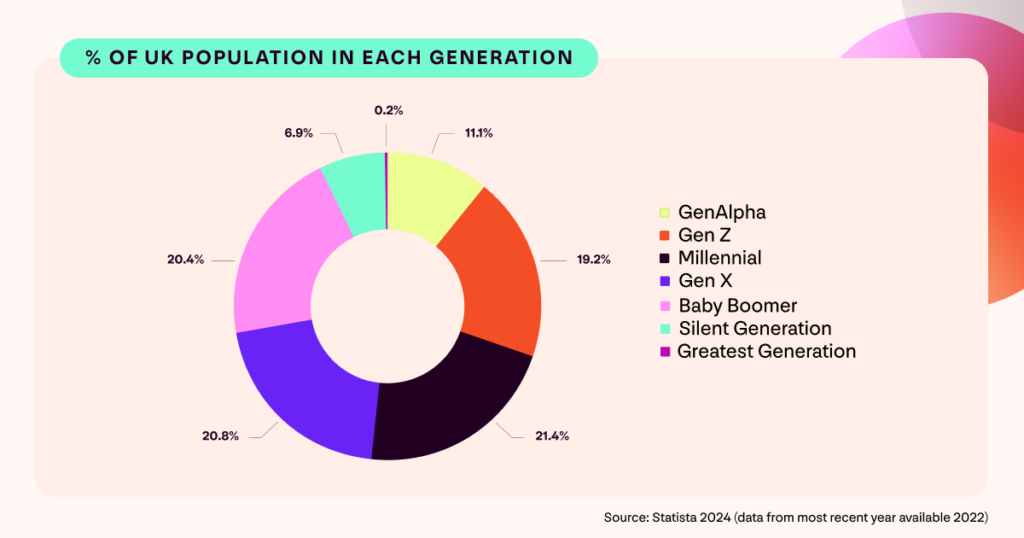
Millennials are making way for Gen Z
The gym membership sales research focused on members (aged 18+) starting their first ongoing commitment at gyms, health, and fitness clubs across the UK.
Zooming in on first time Direct Debit membership agreement starting between January 2013 and March 2024. The research gives a clear picture of how the generational make up of new joiners has changed over the last decade or so.
Over this period, Millennials made up 47.5% of all those starting a first time membership of this kind. For most of the period, Gen X were the second largest group, making up 24.3% of the first time members studied.
However, as the decade progressed on, this trend changed.
The % of first time Millennial members peaked in 2016/2017 and consistently declined since. At the same time, Gen Z started turning 18. And in the years since, the % of first time Gen Z members increased – they’re now the second highest generation behind Millennials.
In Q1 2024 (January to March 2024), the breakdown of first time membership agreements starting by generation looked like this:
- 27.3% – Gen Z
- 40.3% – Millennial
- 21.5% – Gen X
- 10.4% – Baby Boomer
- 0.5% – Silent Generation
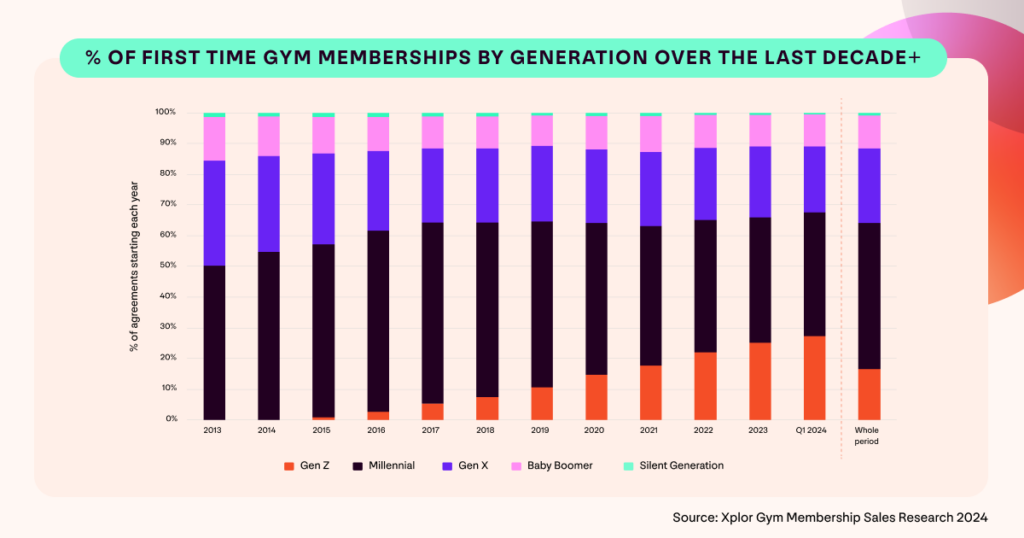
January is the most popular time to start for all but one generation
The gym membership sales research also shows when different generations start their first Direct Debit membership agreements with fitness clubs.
Looking at monthly averages (excluding years with partial data – 2020, 2021, and Q1 2024), January is the most popular time to start an agreement with 11.5% starting at this time. However, that’s different for one generation – Gen Z.
12% of Gen Zers started agreements in September. That compares to 11.2% of Gen Zers starting in January. Gen Xers come closest to this with 10.0% starting in September (and 11.5% of Gen X starting in January).
Baby Boomers are the only generation who see a second peak in October rather than September. 10.2% of Baby Boomers started agreements in October, that compares to 9.2% in September and 11.5% in January.
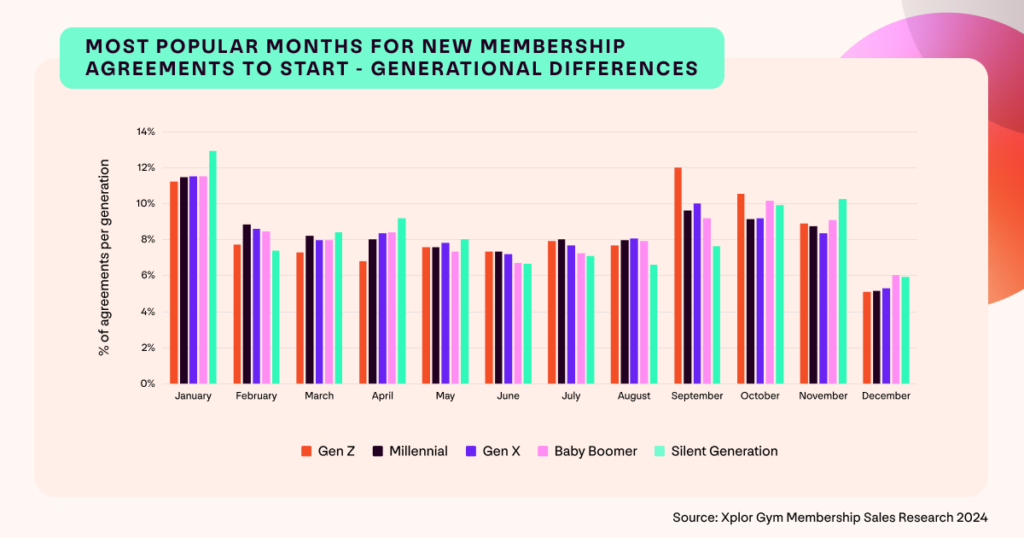
And when it comes to which day of the week agreement start, Monday is the most popular day across all generations.
Weekends are typically the slowest days for starting. But looking across both Saturdays and Sundays combined, a good proportion of younger working age generations started:
- 15.7% of Gen Z
- 15.8% of Millennials
- 17.7% of Gen X
- 13.8% of Baby Boomers
- 9.6% of the Silent Generation
How to increase gym membership sales
Go deeperFind out how to increase gym membership sales across all generations.
Explore nowGeneration x gender breakdown
Looking broadly across all generations, traditionally gyms and fitness clubs have attracted more men than women on average.
Women make up 52% of the UK population. Thanks to changing attitudes and the hard work of organisations like ukactive and Sport England with campaigns like This Girl Can, the gym membership sales research found that women now make up a bigger proportion of first time Direct Debit memberships.
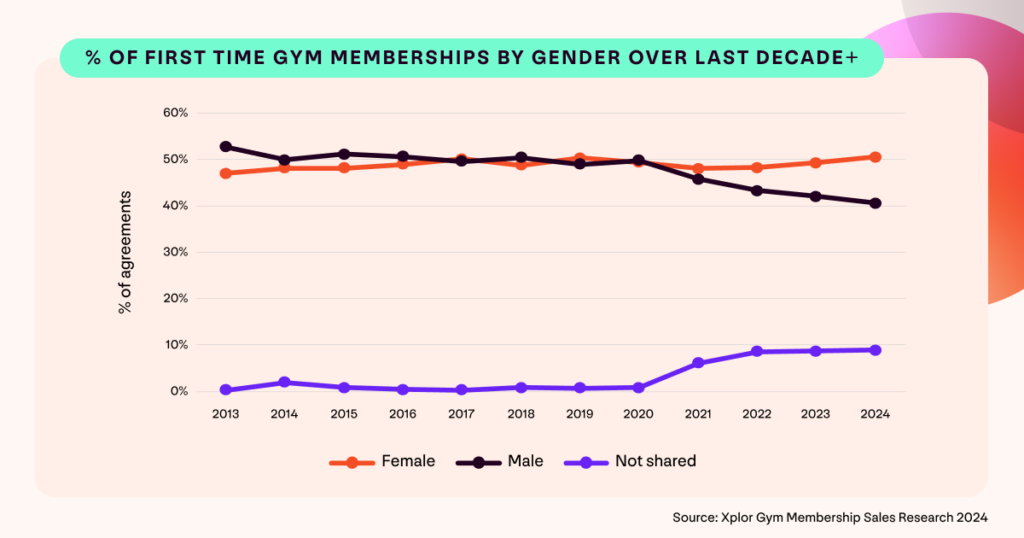
It’s very positive that women now make up a higher percentage of members starting an agreement for the first time. Yet, the increase seen is relatively small – from 47% in 2013 to 51% in Q1 2024.
“If you want to learn more about how to engage women and girls you can access How to improve your services for women and girls: As told by the 51%. This resource is underpinned by research to create a guide developed by ukactive and Sport England’s This Girl Can. It has practical next steps and information to further engage women and girls as long-term members.”
Hattie Jones, ukactive
At the same time, there’s been a decline in the percentage of male joiners that’s greater than the increase in females. In 2013, men made up 53% of first time members studied. That compares to 41% in Q1 2024.
The percentage of people choosing not to share their gender has increased to 9% in recent years. This is to be expected reflecting societal change and increased concern over sharing personal data post-GDPR.
Looking by generation, this declining trend in male joiners is most apparent in Gen Xers and Baby Boomers:
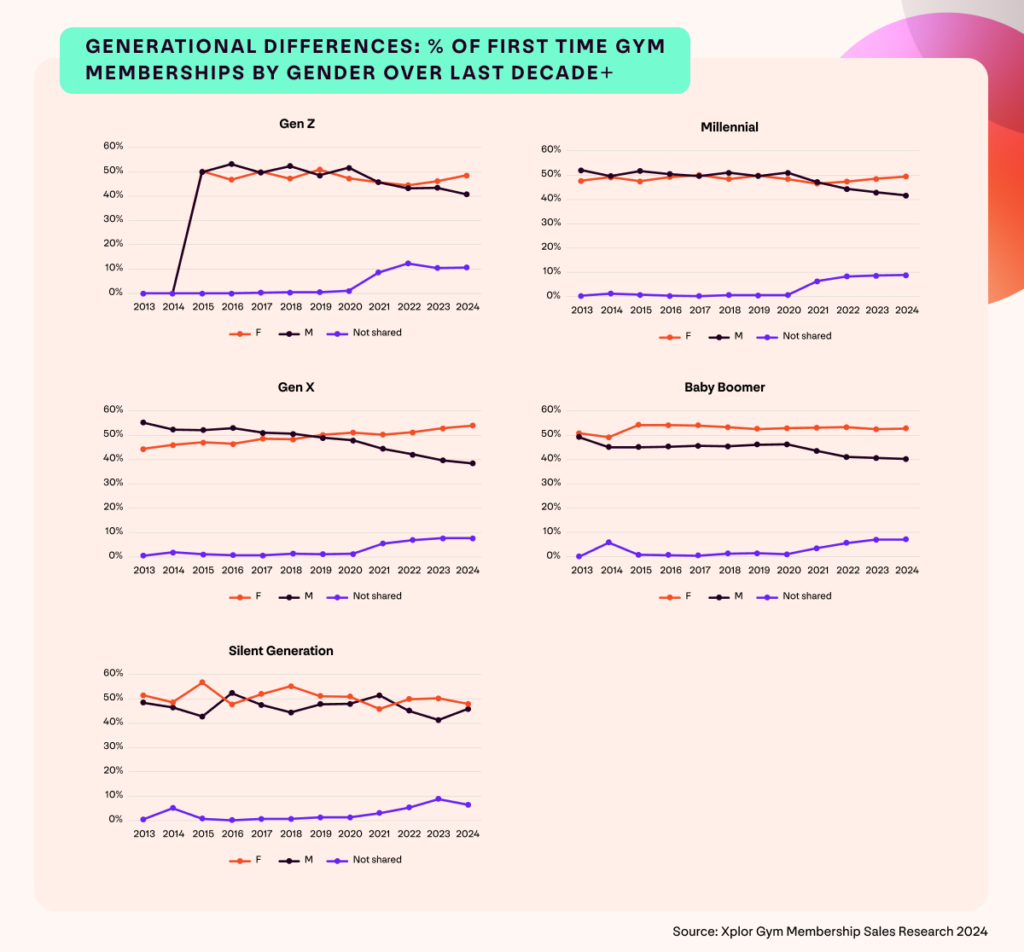
This is a trend to watch
WatchBased on who you’re trying to attract and retain at your club, review your data regularly to see changes in the demographics of your membership base. Look at it overall and at membership sales trends too.
Younger generations end memberships faster
On average, 9.7% of first time Direct Debit members have ended their agreements within 90 days of starting. And the likelihood of this happening is higher for younger members – it’s true for:
- 14.8% of Gen Z
- 10.3% of Millennials
- 7.3% of Gen X
- 4.9% of Baby Boomers
- 4.5% of the Silent Generation
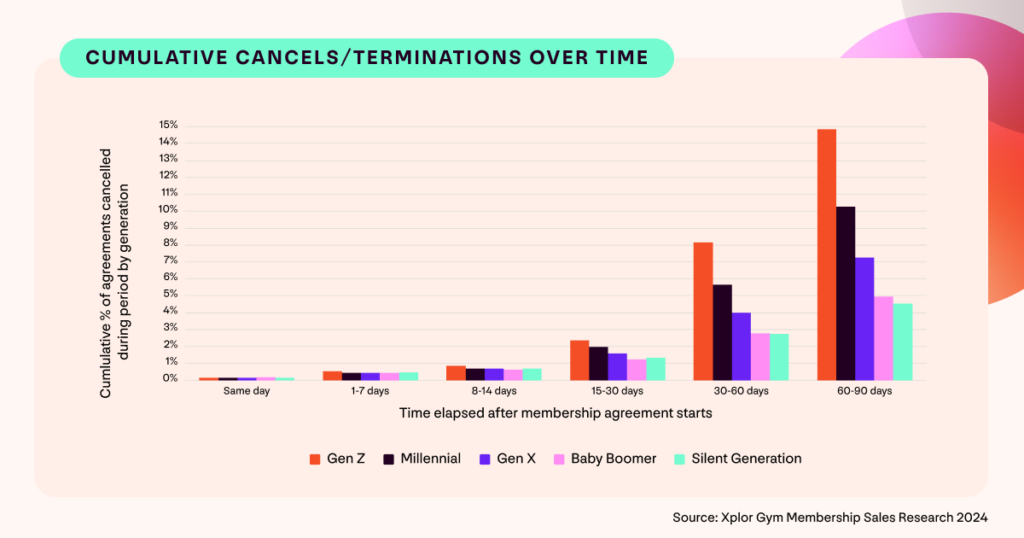
Time to rethink & rebrand the gym induction?
Go deeperHow do you welcome new members? An induction? Find out how to maximise success of inductions and your onboarding process.
Start exploringYounger generations most likely to quietly quit too
Looking at the reasons why first time Direct Debit membership agreements end within 90 days of starting, 51% end silently.
Most commonly that means they come to an end:
- Indirectly with a payment failing or being cancelled via the member’s bank
- Or directly via the gym/fitness club but without a reason shared
Younger generations are most likely to quietly quit when a payment fails or is cancelled via the bank. For those who end up with a terminated agreement within 90 days of starting this is true for:
- 44% of Gen Z
- 38% of Millennials
- 36% of Gen X
- 31% of Baby Boomers
- 26% of the Silent Generation
By comparison, older generations are more likely to cancel directly with clubs early on instead, choosing not to share a reason when doing so:
- 11% of Gen Z
- 11% of Millennials
- 14% of Gen X
- 17% of Baby Boomers
- 17% of the Silent Generation
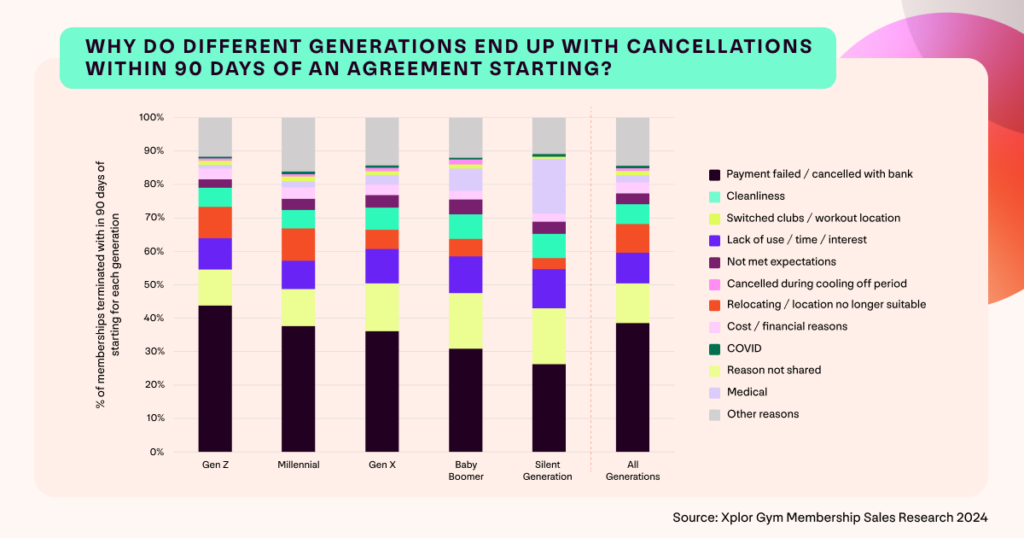
How (& when) to win back gym members who cancel
Go deeperWant to win back members who cancel early? Get tips for success.
Explore nowThe wrap up…
Understanding generational trends will help you identify opportunities to better reach different groups. So, you can attract and retain more new members.
The gym membership sales research shows some key trends when it comes to first time Direct Debit membership agreements that started at gyms and fitness clubs across the UK over the last decade.
Most of these first time members were Millennials. And Gen X made up the second highest proportion for most of the decade. In the past few years, Gen X have been over taken by Gen Z.
January is the most popular time to start a membership agreement for pretty much every age group. Except Gen Z who tend to start in September. Mondays are by far the most popular day to start for all other generations. Saturday and Sunday tend to be quietest, but are more popular with younger generations of working age.
Women make up an increasing percentage of the first time members studied. The decline in male joiners is most apparent in Gen X and Baby Boomers. Perhaps in part due to the higher likelihood of them having been a member paying by Direct Debit in the past.
Younger generations are more likely to end memberships within 90 days of starting than older generations. And are most likely to do so indirectly by missing a payment or cancelling a mandate at their bank.
Get more insights and expert tips to help you win and retain members of all ages. Claim your free copy of the Gym Membership Sales Report.

by Xplor Gym
-
First published: 14 October 2024
Written by: Xplor Gym
